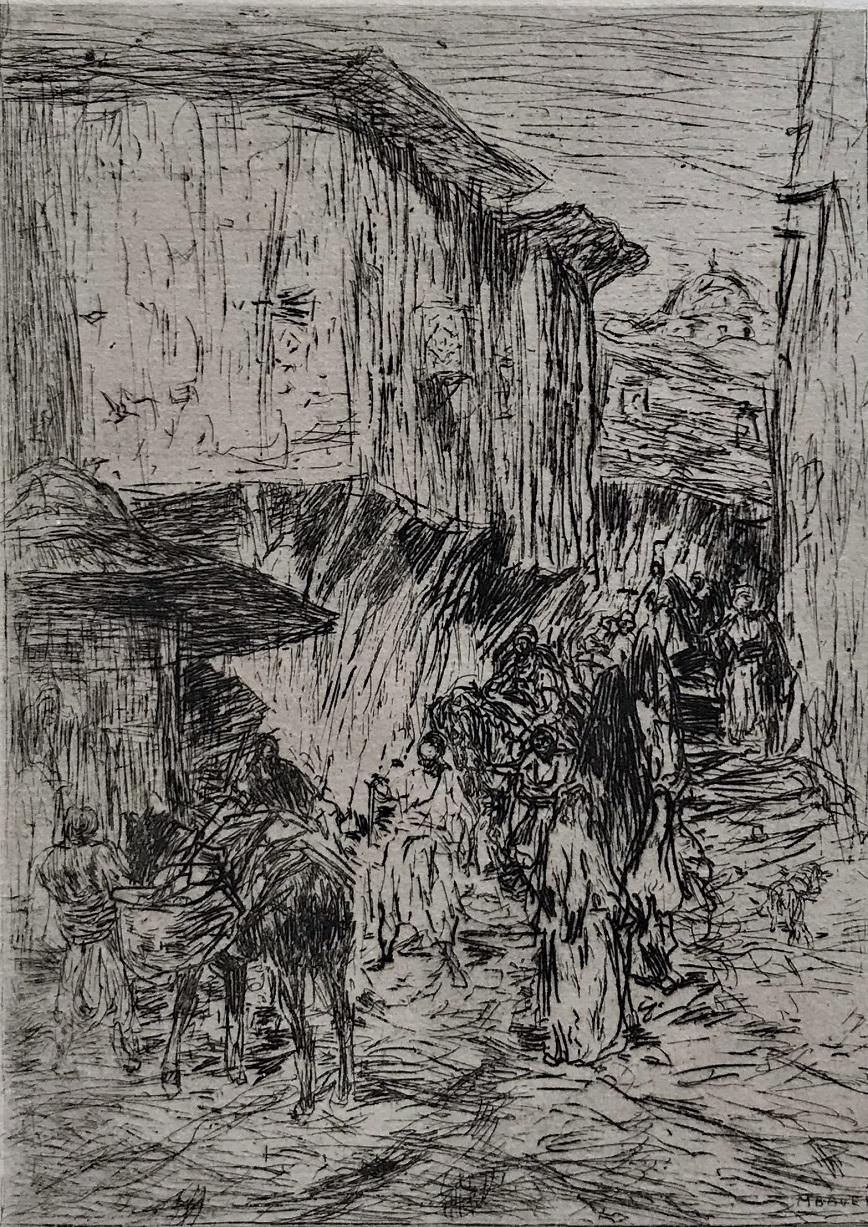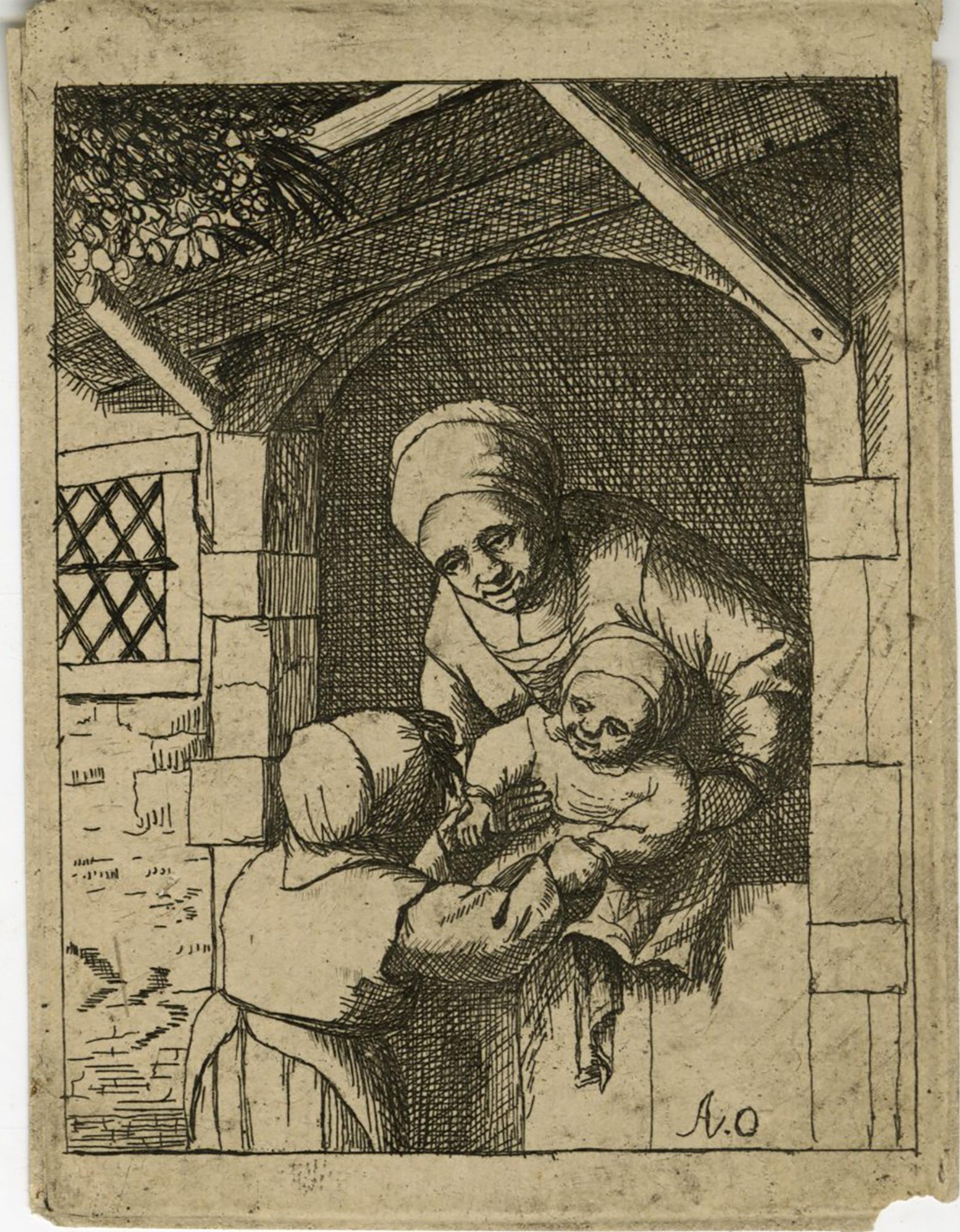Items Similar to Que se la Llevaron! - Etching by Francisco Goya - 1799
Want more images or videos?
Request additional images or videos from the seller
1 of 2
Francisco GoyaQue se la Llevaron! - Etching by Francisco Goya - 17991799
1799
About the Item
Que se la Llevaron! is an original etching realized by Francisco Goya in 1799, from Los Caprichos series.
The artwork is the plate 8 (as printed on plate on the higher right margin) from the series Los Caprichos, first edition.
Good conditions.
Los Caprichos.
Put on sale the 6 February 1799, at the end of the last carnival of the century, Los Caprichos, first Goya’s printed cycle created as a unit, can be located in a period of transition in the artist’s life. Actually, in the last decade of the eighteenth century, there were some facts very important for Goya, as the illness and the hearing loss.
These engravings are made in 1797 in Madrid, after the artist’s stay in Andalusia, where he was guest of the Duchess of Alba.
In 1797 Gaspar Melchor de Jovellanos, the most important deputy of the spanish Age of Enlightenment and Goya’s protector, accepted the Ministry of Mercy and Justice and started to promote a splendid environment for the artistic expression. The same year, the first version of this set (72 engravings) was printed entitled as Sueño 1º Idioma Universal. In january of 1799, the definitive edition (80 engravings) of the Caprichos was published.
This cycle can be divided into two parts, each of these is introduced by a self-portrait of the artist.
In the first self-portrait, that anticipates 41 realistic scenes (2-42), Goya represents himself as a middle-class man who has a sarcastic vision of the world, the main subject of his Caprichos. In the second portrait, he images himself asleep amidst his drawing tools, with monsters behind him produced by the reason dulled.
The Caprichos are a strong aesthetic and social provocation; french poet Baudelaire said about Goya’s masterpiece: “ No one artist more than Goya dared the sense of the absurd possible. All these contortions, these bestial faces, these diabolic sneers are infused with humanity […] it’s impossible find the suture, the point of union between real and fantastic; it’s a line so unclear that also the finest analyst can’t draw, in an art that is, at the same time, so transcendent and natural”.
Francisco José de Goya y Lucientes (March 30th 1746 - Bordeaux, April 16th 1828), Francisco Goya, the Spanish painter and printer, was one of the rare artists that, through their work, not only gain the recognition and admiration of their contemporaries, but influence the development of future art.
Born in Fuentedetodos to a middle-class family originating from Aragona, he was the forth of six brothers.
Studying with José Buzàn y Martinez, and in Madrid under Velasquez, and entered the group of R. Mengs where he met Tiepolo. After going to Roma and Venice, he returned to Spain to paint the dome of Santa Maria of Pilar basilica in Zaragoza with frescoes showing Tiepolo's influence. In Madrid he was uncomfortable with his academic style, despite the fame gained in the king's court for his very lively style and refined artistic taste. He had started his most productive and busy period of his life. He returned to Zaragoza to paint frescoes in the cathedral (commissioned by Bayeu) but left the work incomplete and instead started to paint portraits and also started “Caprichos”.
Goya's main success was under the reign of Carlo IV but when the power of Ferdinandi VII increased under the French occupation, he went into exile in Bordeaux. In 1799 he painted the family portrait of Carlo IV and attracted the friendship of the king. Goya was close to the poor, something that is reflected in the “Desastres de la guerra” print, and to which he dedicated his work during his stay in France. Goya travelled to Zaragoza to paint the companies of the Spanish resistance, but left Spain for Bordeaux after the onset of deafness and painted the Milkmaid of Bordeaux. He died in Bordeaux in 1828.
- Creator:Francisco Goya (1746 - 1928, Spanish)
- Creation Year:1799
- Dimensions:Height: 8.47 in (21.5 cm)Width: 5.99 in (15.2 cm)Depth: 0.08 in (2 mm)
- Medium:
- Movement & Style:
- Period:1790-1799
- Framing:Framing Options Available
- Condition:Insurance may be requested by customers as additional service, contact us for more information.
- Gallery Location:Roma, IT
- Reference Number:
About the Seller
4.9
Platinum Seller
These expertly vetted sellers are 1stDibs' most experienced sellers and are rated highest by our customers.
1stDibs seller since 2017
Typical response time: 2 hours
- ShippingRetrieving quote...Ships From: Rome, Italy
- Return PolicyA return for this item may be initiated within 14 days of delivery.
More From This SellerView All
- The Family - Original Etching by Jean-Louis Demarne - 18th centuryLocated in Roma, ITThe Family is an Original Etching realized by Jean-Louis Demarne (1744-1829). The little artwork is in good condition, included a light green cardboard passpartout (49x31.5 cm). Stamp signed on the lower right corner. Jean-Louis de Marne (1752-24 March 1829) was a French painter. He concentrated on landscape and genre painting, in which he was greatly influenced by such 17th century Dutch masters as Aelbert Cuyp...Category
18th Century Old Masters Figurative Prints
MaterialsEtching
- Ancient Roman Fresco - Original Etching By F. Cepparuli - Mid-18th CenturyBy Francesco CepparuliLocated in Roma, ITFrancesco Cepparuli, Ancient Roman Fresco, original etching hand watercolored. Mid-18th Century. original etching from the end of the 18th century, realized by Francesco Cepparuli. ...Category
Late 18th Century Old Masters Figurative Prints
MaterialsEtching
- Cave Rue de l'Enfer - Original Etching by Augustin André Lançon - 1871Located in Roma, ITCave Rue de l'Enfer is an original Etching realized by Augustin André Lançon in 1871. Rare etching belonging to the suite "Guerre de 1870 et Siège de Paris". Very good Conditions. ...Category
1870s Old Masters Figurative Prints
MaterialsEtching
- Chiesa di S. Paolo alle Tre Fontane - Etching by G. Vasi - Late 18th CenturyBy Giuseppe VasiLocated in Roma, ITChiesa di S. Paolo alle Tre Fontane is an original black and white etching of the Late 18th century realized by Giuseppe Vasi. The beautiful etching represents a glimpse of Rome. S...Category
Late 18th Century Old Masters Figurative Prints
MaterialsEtching
- Chiesa della SS. Trinità - Etching by G. Vasi - Late 18th CenturyBy Giuseppe VasiLocated in Roma, ITChiesa della SS. Trinità is a black and white etching of the Late 18th century realized by Giuseppe Vasi. Signed and titled on plate lower margin. Good conditions and aged margins...Category
Late 18th Century Old Masters Figurative Prints
MaterialsEtching
- Palazzo Altieri - Etching by Giuseppe Vasi - Late 18th CenturyBy Giuseppe VasiLocated in Roma, ITPalazzo Altieri is an original black and white etching of the Late 18th century realized by Giuseppe Vasi. Signed and titled on plate lower margin. Quite Good conditions and aged ...Category
Late 18th Century Old Masters Figurative Prints
MaterialsEtching
You May Also Like
- A study of whimsical architectural elements: Satyr's, Torch, Sphynx, Sea MonsterLocated in Middletown, NYEtching on handmade laid paper with a large, indiscernible heraldic watermark, , trimmed inside platemark. Several light spots of foxing along right edge, verso, one area of light th...Category
Mid-17th Century Old Masters Figurative Prints
MaterialsLaid Paper, Etching
- Market DayBy Marius BauerLocated in Storrs, CTMarket Day. 1889. Etching and drypoint. Wisselingh 42. 7 5/8 x 5 13/16 (sheet 8 3/8 x 6 3/8). Edition 100. Printed on cream laid paper. Mat burn and toning ...Category
Late 19th Century Old Masters Figurative Prints
MaterialsEtching
- OBSEQUIO á el MAESTRO (‘A gift for the master’)By Francisco GoyaLocated in Santa Monica, CAFRANCISCO de GOYA y LUCIENTES (1746 -1828) OBSEQUIO á el MAESTRO (‘A gift for the master’) Plate 47 from the 1st edition of Los Caprichos (Blas, ...Category
1790s Old Masters Figurative Prints
MaterialsEtching, Aquatint
- "Nohubo remedio" (There was no remedy) - Etching and Aquatint on PaperBy Francisco GoyaLocated in Soquel, CA"Nohubo remedio" (There was no remedy) - Etching and Aquatint on Paper Bold 3rd or 4th edition, circa 1868-1878, with burnished aquatints, drypoints etching, and engravings by Franc...Category
1790s Old Masters Figurative Prints
MaterialsEngraving, Paper, Etching, Aquatint
- Little Girl Playing with a Baby in its Mother's ArmsBy Adriaen van OstadeLocated in Middletown, NYDeuchar, David, (after van Ostade). Little Girl Playing with a Baby in its Mother's Arms; Mother with Two Children. Edinburgh: c 1800. Etching on cream laid paper, 3 3/4 x 2 3/4 inch...Category
19th Century Old Masters Portrait Prints
MaterialsEtching, Laid Paper
- Jan Cornelis SylviusBy Rembrandt van RijnLocated in Middletown, NYHeliogravure on cream laid paper, 6 1/2 x 5 1/2 inches (164 x 138 mm), thread margins. Uniform toning on the recto, and scattered light foxing and various notations in purple ink and...Category
19th Century Old Masters Portrait Prints
MaterialsHandmade Paper, Laid Paper, Etching
Recently Viewed
View AllMore Ways To Browse
Antique Old Tools
Old Tools Antique Tools
Old Antique Tools Tools
Old Antique Tools
Old Antique Tool
Antique And Old Tools
Old Masters For Sale
Antique Se
After Goya
Set Of 6 Etchings
16th Century Style Portrait
Francisco De Goya
Original Etching 16th Century
Old Master Drawing 16th
Antique Drawing Tools
Antique Cycling Prints
Antique Engraving Tools
R T Facts





